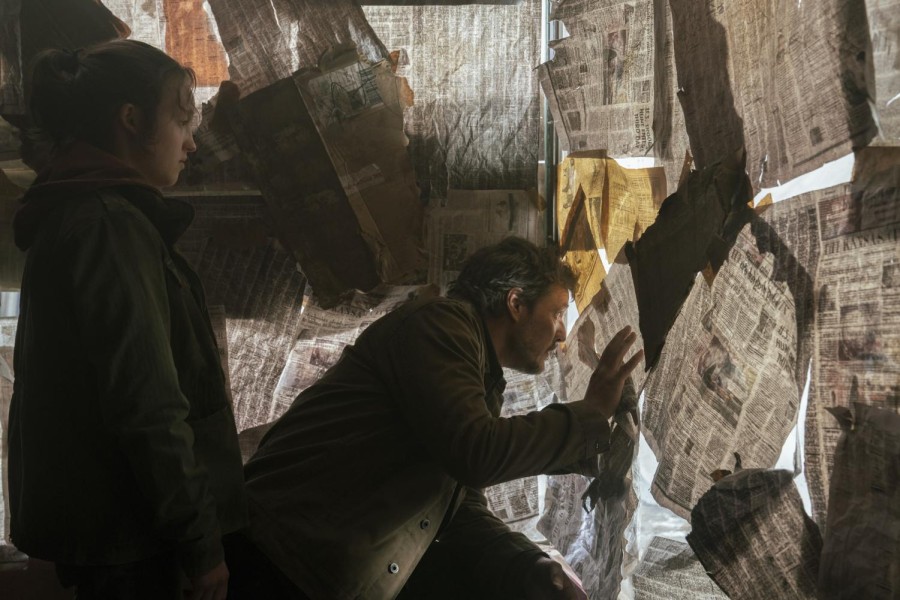‘The Last of Us’ brings its source game to life in the best way possible
This January, fans of the iconic zombie survival video game “The Last of Us” get to revisit the story of Ellie and Joel on HBO Max almost 10 years after the original game released.
Pedro Pascal and Bella Ramsey star in the hit television adaption of the video game “The Last of Us.” (Courtesy of Warner Media)
February 6, 2023
“The Last of Us” is a name avid gamers know all too well. Recently, the popular video game was adapted into a TV show on HBO Max with a star-studded cast featuring the likes of Pedro Pascal, Bella Ramsey, Storm Reid, Nicholas Offerman and Merle Dandridge.
The series follows Joel and Ellie as they travel across a post-apocalyptic United States, grappling with a viral outbreak that arose from a fungal infection of Cordyceps. The disease is generally airborne, but can also be spread through contact and surfaces, and it transforms those who contract it into zombies.
For a generation of young fans emerging from a deadly pandemic, and raised on popular dystopian franchises like “The Hunger Games,” “The Maze Runner” and “Divergent,” the series offers a strangely comforting story for audiences looking to process anxieties about our world’s future. Watching “The Last of Us,” you want to immerse yourself in its world despite all its chaos, because its well-detailed setting and memorable characters reflect our encounters with our peers as we all live through the often harrowing parameters of our almost-dystopian times.
In “The Last of Us,” Joel (Pedro Pascal) is tasked with delivering Ellie (Bella Ramsey) to an undisclosed location in exchange for a truck to find his brother. As we follow this narrative, the show flashes back to the initial days of the outbreak in 2003 to explain its evolution to the present day, when the show is situated. The series does many things right and is faithful to the original video game, especially with how it enables audiences to sympathize with the tension and stress that Joel and Ellie feel navigating the viral outbreak.
The television adaptation is a gift to those who eagerly played the video game almost 10 years ago. But, at the same time, it is also accessible enough to those who have never even heard of the game — the ones who merely opened up HBO Max and decided to enter a post-apocalyptic, zombie-infested world on a whim.
Though this basic formula has been executed before — such as in the award-winning adaptation of the comic book series “The Walking Dead” — “The Last of Us” differentiates itself by appealing to a variety of ages. Its depiction of Joel, a world-weary veteran of the apocalypse, may resonate with older audiences affected by our ongoing pandemic, while its depiction of Ellie, a teenager coming of age in a new reality, may resonate with younger audiences growing up in a confusing, turmoil-stricken world. in its depiction of Joel, a veteran of this apocalypse whose wearied disposition may resonate with older audiences affected by our ongoing global pandemic, and Ellie, a teenager born into this new reality still trying to figure its ins-and-outs.
Both the video game and the series portray a realistic father-daughter dynamic between the protagonists, although the two are not actually related. Joel, the father figure, is reserved, and has a more pessimistic view of the world, while Ellie, the daughter figure, holds out hope for the future despite her constant frustrations with her life and current situation.
From the intimate moments between Joel and Ellie to the fear of seeing a zombie jump scare, I’m instantly transported back 10 years to a time in my life when I wanted an escape. Even now, I still want to be among the remaining survivors of the apocalypse living in the quarantine zone from the second episode, or Bill and Frank’s home in Massachusetts from episode three.
Only four episodes of “The Last of Us” have come out, but it’s safe to say that the show demonstrates the role of television as an arena to explore how we might build a world in the aftermath of global trauma and devastation. The story of Joel and Ellie is especially important in today’s climate with its narrative focus on the universal themes of love and acceptance in a time when the world is plagued by health and environmental issues.
Ultimately, the message comes down to a question constantly raised throughout “The Last of Us,” a question we all must ask ourselves: “What would you do for the people you love?”
“The Last of Us” will continue to air episodes on Sundays at 9 p.m. on HBO Max.
Contact Pritheva Zakaria at [email protected].
























































































































































